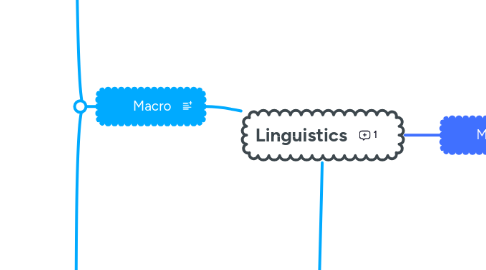
1. Macro
1.1. Inter Disciplinary
1.1.1. Sociolinguistic
1.1.1.1. Regional
1.1.1.1.1. Dialect
1.1.1.1.2. Accent
1.1.1.2. Social
1.1.1.2.1. Socialect
1.1.1.3. Functional
1.1.1.3.1. Register
1.1.1.3.2. Jargons
1.1.1.3.3. Gender Difference
1.1.2. Psycholinguistic
1.1.2.1. Language acquisition
1.1.2.1.1. Pre-Birth
1.1.2.1.2. Babling
1.1.2.1.3. One-word
1.1.2.1.4. Two- word
1.1.2.1.5. Telegraphic
1.1.2.1.6. After Telegraphic
1.1.2.1.7. Bilingualism
1.1.3. Applied linguistics
1.1.4. Stylistic
1.1.5. Cognitive Linguistics
1.1.6. Computational linguistics
1.2. Intra Discipliary
1.2.1. Applied
1.2.2. Theoretical
1.2.3. Historical
1.2.3.1. Diachoronic analysis
1.2.3.2. Synchronic analysis
1.2.3.3. Converge
1.2.3.4. Diverge
1.2.3.5. Proto-language
1.2.3.5.1. Language Isolate
1.2.3.5.2. Language family
1.2.3.6. Cognate
1.2.4. Descriptive
1.2.4.1. Writing system
1.2.4.2. Language classification
1.2.4.2.1. Genetic
1.2.4.2.2. Typology
1.2.4.3. Descriptive
1.2.4.3.1. Language classifications
1.2.4.4. Classification
1.2.4.4.1. Genetic
1.2.4.4.2. Typological
1.2.5. Comparative
2. Micro
2.1. Phonetics
2.1.1. Articulatory
2.1.1.1. speech perception
2.1.1.1.1. McGurk effect
2.1.1.1.2. categorical perception
2.1.2. Acoustic
2.1.3. Auditory
2.1.4. Phoneme
2.1.5. Allophone
2.2. Phonology
2.2.1. The International Phonetic Alphabet (IPA
2.2.1.1. allomorph
2.2.1.2. Consonants
2.2.1.2.1. Place
2.2.1.2.2. Manner
2.2.1.2.3. Nasality
2.2.1.3. Vowels
2.3. Morphology
2.3.1. Morpheme
2.3.1.1. Free morpheme
2.3.1.2. Bound morpheme
2.3.1.3. Open-class
2.3.1.4. Closed-class
2.3.1.5. Word formation
2.3.1.5.1. Blending
2.3.1.5.2. Compounding
2.3.1.5.3. Affixation
2.3.1.5.4. Clipping
2.4. Semantics
2.4.1. Slang
2.4.2. Idioms
2.4.3. Metaphors
2.4.4. Irony
2.4.5. Jargon
2.4.6. Everyday expressions
2.4.7. Hyperbole
2.4.8. Emojis
2.4.9. Sarcasm
2.4.10. Colloquialisms
2.4.11. Synonyms
2.4.12. Antonyms
2.4.13. Homophones
2.4.14. Polysemy
2.4.15. Puns
2.4.16. Connotation
2.4.17. Euphemisms
2.4.18. Taboo Language
2.5. Pragmatics
2.6. Syntax
2.6.1. Transitive Noun Phrase
2.6.2. Intransitive Adverbial Modifier
2.6.3. Linking Adverbial Complement
2.6.4. Linking Adjectival Subject Complement
2.6.5. Linking Nominal Subject Complement
2.6.6. **PREDICATE**
2.6.6.1. SUBJECT
2.6.6.2. PREDICATE
2.6.7. OBJECT
2.6.7.1. DIRECT
2.6.7.2. INDIRECT
